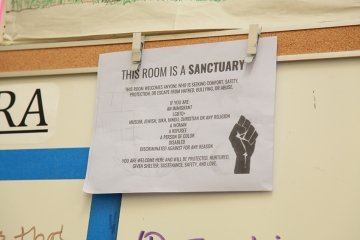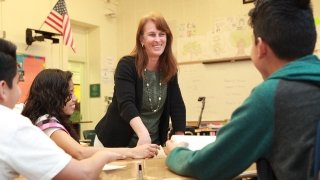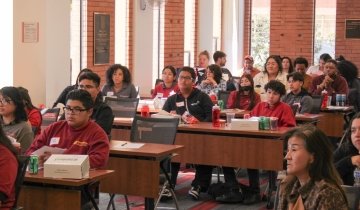
“This Room is a Sanctuary” reads the poster pinned to the blackboard in teacher Mike Bin’s classroom at Belmont High School in downtown Los Angeles. Since Donald Trump won the White House on a platform of tighter immigration control, that message has resonated at this campus with 1,050 students, many of whom are immigrants or the children of immigrants from Central America and Mexico.
“These are children coming from war-torn, difficult, dangerous places, who are coming here for the American Dream,” says Principal Kristen McGregor ’85, EdD ’07, who is also an adjunct assistant professor in USC Rossier’s Master of Arts in Teaching program.
Many of the students identify as DREAMers, a term coined from the 2010 DREAM Act (Development, Relief and Education for Alien Minors). Although that policy did not pass the House of Representatives, two years later President Barack Obama signed into law the Deferred Action for Childhood Arrivals (DACA) program, which offers a work permit and temporary reprieve from deportation to people who were brought to the United States as children and remained in the country without authorization.
“So there is fear when you say we’re going to build a wall and kick out all of these people,” says McGregor.
She and her staff have responded by opening their arms wider.
“I say I’m mom to 1,000 kids. I tell them, ‘You’re my babies. I’m going to protect you,’” the veteran educator says.
To address their concerns, McGregor has met individually with students and their families to answer questions. She has encouraged teachers to discuss the controversy over immigration policy in class without taking sides and with an emphasis on the resources available to students to move forward with their education.
Through classroom presentations, Belmont has provided students with information about their rights and referrals for legal advice and other services. More basic needs of the predominantly low-income student body are also met. In storage areas near her office, McGregor stocks donated canned food items, coats, sweaters and other used apparel.
“My job is to make sure we have an educated society,” she says. “I want to keep these kids in school and give them as many opportunities as possible.”
SAFE ZONES
Belmont is part of the Los Angeles Unified School District (LAUSD), where schools were declared “safe zones” by the Los Angeles Board of Education last year. The board instructed campus administrators that any Immigration and Customs Enforcement agents who attempt to enter schools in search of students be sent to district headquarters.
So far the policy has not been tested, but anxiety runs high. In March, federal agents detained a man near a public charter school in Lincoln Heights, where he had just dropped off his 12-year-old daughter. The incident further rattled students already worried about themselves or friends and family who lack authorization to live in the United States.
“The level of anxiety for these students is very difficult for a teacher to see,” says Bin, an algebra and English-language development teacher in his 21st year at Belmont.
“You hear it in the way they talk to each other,” he continues. “I hear things like, ‘Did they actually deport somebody who was walking down the street? Am I going to be grabbed next? Do I have to start hiding now? Are they going to take my father or mother away from me?’”
The toll on students could be gauged in the first few months of 2017 by at least one important measure: Applications for college financial aid were down (see “Quit does not exist,” p. 25).
According to McGregor, 70 percent of Belmont’s seniors completed the Free Application for Federal Student Aid, or FAFSA, last year. This year, only 42 percent had applied through early March. Principals at other district high schools had noted similar declines, she says.
Alarmed by the drop, McGregor and her staff redoubled their efforts and brought the total up to 77 percent, better than last year.
Extra resources from a federal grant to prepare low-income students for success in postsecondary education have helped Belmont keep track of college-bound students while providing support for students needing help writing essays and filling out applications.
Bin says he wished that President Trump and others calling for a crackdown on illegal immigration could meet his students. Three days a week after school, up to 45 pupils in various stages of learning English voluntarily gather in his room to be tutored by other students. The tutors get free popcorn and community service credit while their pupils receive free help in math and English.
For many students, it isn’t easy to give up an hour out of their day. Like other students who entered the country without parents, Marcus (not his real name), an undocumented 17-year-old from El Salvador, has to work to support himself. He starts most days at Belmont after working from 6 p.m. to 2 a.m. as a busboy.
It’s an exhausting schedule, but Marcus has progressed rapidly in English and has a solid B in Bin’s math class. “I want to have a better future,” Marcus says. He is considering college.
Melvin came from El Salvador at age 17 with his mother and had a job as a mechanic before enrolling at Belmont. Now 20, he is in the 11th grade and working toward his diploma and legal residency.
After he graduates from Belmont, he would like to study mechanical engineering in college.
“It will be hard,” he says, “but not impossible.”




